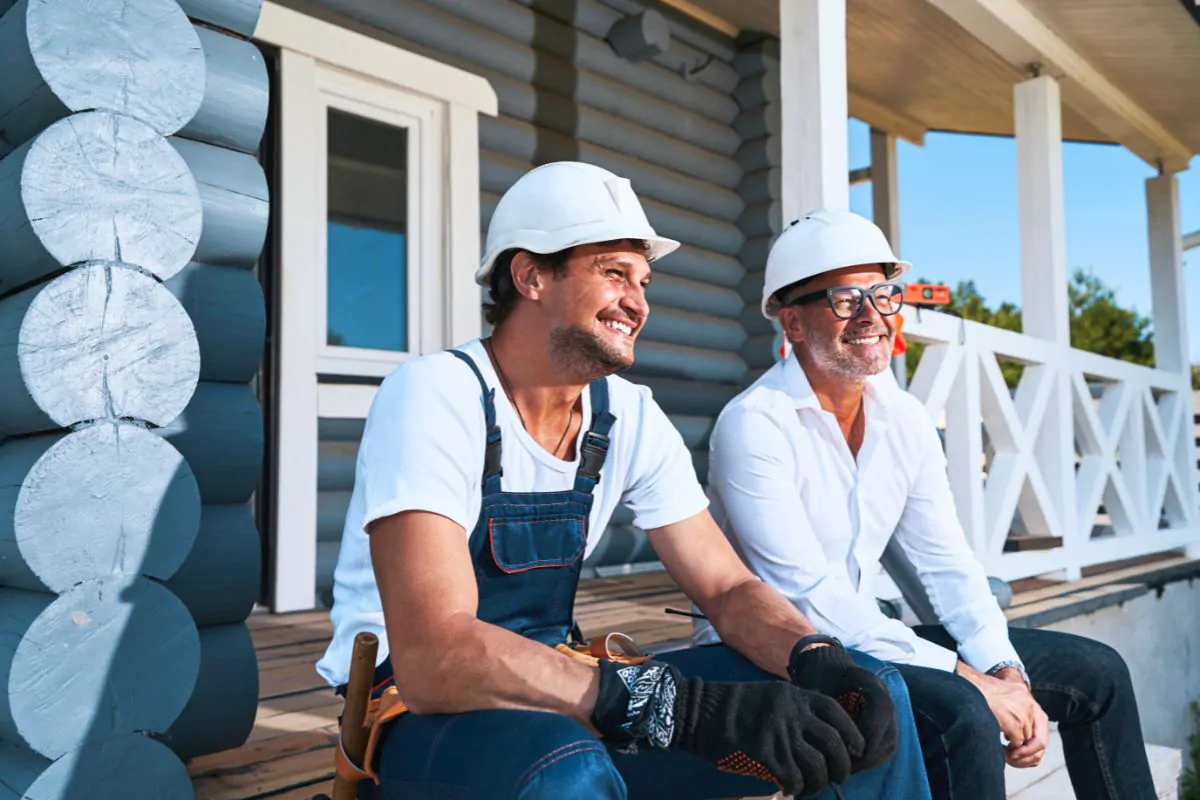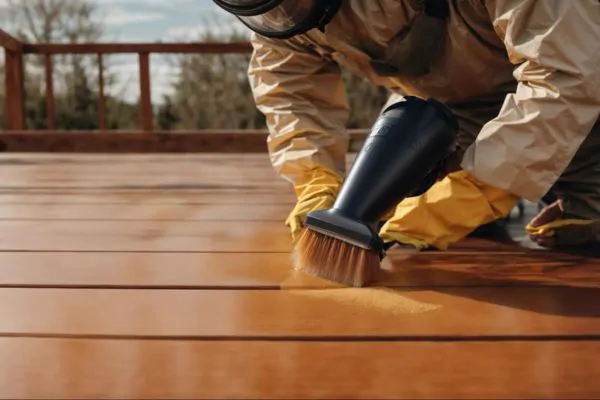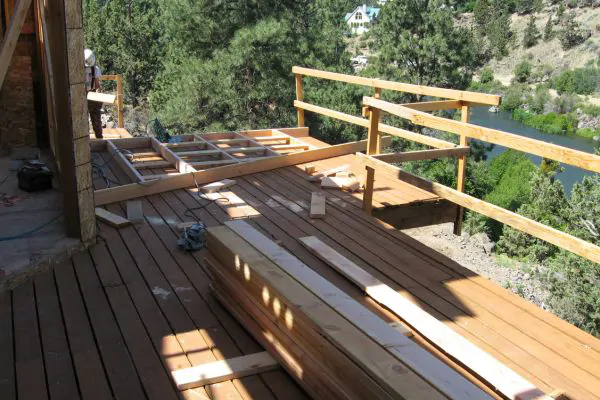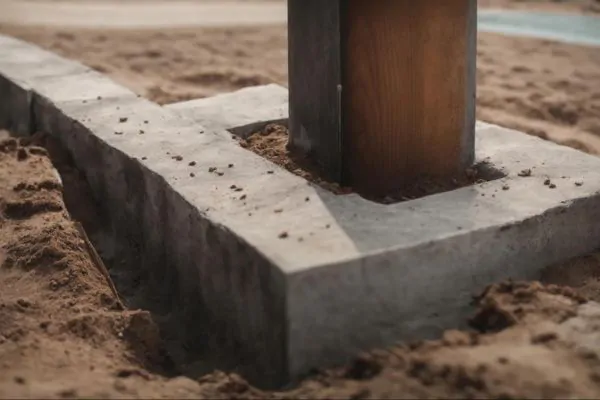
Do you know what can happen when a deck footing is poorly made? Inadequate footings may lead to instability, causing the deck to sway, wobble, or even sink into the ground over time.
Also, a lack of depth or proper materials can result in the footing settling unevenly, leading to an uneven deck surface. It’s a safety hazard that will mess up the entire structure.
Deck footings are a critical component of any deck structure, and their proper installation is crucial for ensuring a stable and durable deck. In this short article, we’ll discuss the different deck footing options, considerations for choosing the right one, and much more.
Decoding the Essentials of Deck Footings
Definition and Role of Deck Footings
First things first, what are deck footings? Deck footings are foundational components crucial for the structural integrity of a deck. Essentially, these supporting structures bear the load of the entire deck, transferring it from the structure to the ground. Typically made of concrete, deck footings are strategically placed beneath support posts to distribute weight evenly and prevent settling or uneven weight distribution.
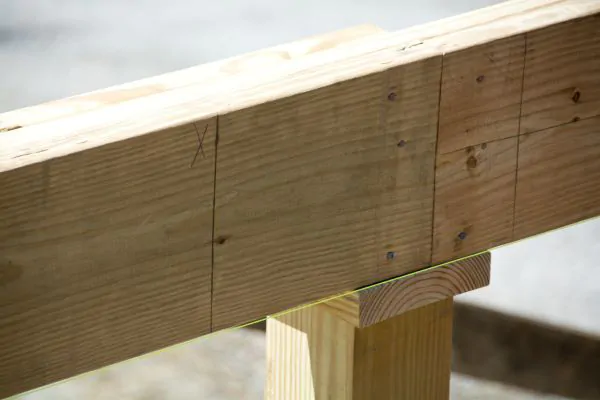
Their role is akin to that of a building’s foundation, providing a stable base that ensures the entire deck structure remains level and secure. Without properly constructed footings, a deck is susceptible to instability, sagging, and other structural issues that can compromise its safety and longevity.
An Experienced Local Deck Contractor Will Consider the Frost Line
As you know, it snows heavily in Connecticut. A reliable deck contractor, like Fairfield County Deck Builders, makes sure our customers’ decks remain undamaged from the cold temperature. The frost line, also known as the frost depth or freezing depth, is the depth at which the ground in a specific geographic area is expected to freeze during the winter season. The significance of the frost line in construction, including building a deck, lies in the potential impact of frost heave.
Frost heave is a phenomenon that occurs when the ground freezes, and the moisture in the soil turns into ice. As water freezes, it expands, and this expansion can exert significant pressure on anything above it. In the context of deck construction, if the footings or support posts of a deck extend above the frost line, there is a risk that the frozen ground could push against them, causing the deck to heave or shift.
To prevent these issues, it is essential to build structures, including decks, with foundations that extend below the frost line. This helps ensure that the footings and support posts are anchored in stable, unfrozen soil, reducing the risk of movement and damage caused by frost heave.
Importance of Proper Weight Distribution and Load-Bearing Capacity
Proper weight distribution and load-bearing capacity are paramount for the longevity and safety of a deck. Deck footings play a pivotal role in ensuring that the weight of the deck, including furniture, occupants, and other loads, is evenly distributed to prevent overloading specific areas.
The load-bearing capacity of footings is designed to match the anticipated load, and this is crucial for preventing structural failure. Anticipating for live and dead loads is a common concept in structural engineering. Adequate weight distribution not only safeguards against immediate issues like sagging or instability but also contributes to the overall durability of the deck by minimizing wear and tear on the supporting elements. By adhering to load-bearing capacity guidelines and distributing weight effectively, deck footings promote a secure and long-lasting outdoor structure.
Related Post: Deck Construction And Design Guide
Deck Footings with Piers and Sonotubes
Overview of Concrete Piers as a Traditional Deck Footing Option

Among the deck footing types, concrete piers stand out as the traditional choice. It’s a longstanding and reliable choice for deck footings, and they serve as sturdy foundational pillars, supporting key load-bearing points of the deck structure. Typically composed of reinforced concrete, these cylindrical structures efficiently distribute the deck’s weight to the underlying soil.
Renowned for their durability and resistance to settling, concrete piers provide a robust foundation, contributing significantly to the structural integrity and overall stability of the deck.
Advantages of Using Sonotubes for a Cleaner and Simpler Installation
For those prioritizing a streamlined installation process, Sonotubes offers a practical alternative to traditional concrete piers. These cylindrical forms, often constructed from fiber or cardboard, facilitate a simplified installation method.
Easily positioned and filled with concrete, Sonotubes reduce labor and material requirements, resulting in a cleaner and more efficient construction experience. Particularly advantageous for DIY projects or those with time constraints, Sonotubes provides a convenient option for achieving secure and stable deck footings.
Considerations for Soil Conditions and Frost Depth
Careful consideration of soil conditions and frost depth is paramount to ensure the deck’s longevity. The stability and type of soil directly impact the load-bearing capacity of the footings, influencing their effectiveness in supporting the deck. Understanding the local frost depth is crucial to mitigate the risk of frost heaving, where the ground expands and contracts with freezing temperatures.
By addressing these factors during the planning and installation phases, deck footings can adapt to varying soil conditions and withstand seasonal changes, reinforcing the deck’s stability and resilience against environmental challenges.
Helical Piles and Screw-In Footings
Exploring the Efficiency of Helical Piles in Various Soil Types
Helical piles, also known as screw piles, are garnering attention for their efficiency across various soil types. These innovative footings feature a helix-shaped plate welded to a steel shaft, allowing them to be screwed into the ground with relative ease.
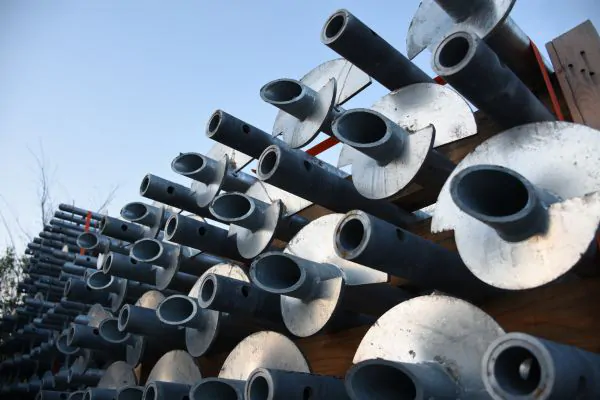
What makes helical piles versatile is their adaptability to different soil conditions. Whether dealing with soils heavy in sand, clay, or loam, helical piles can provide stable support. Their design minimizes disturbance to the soil during installation, making them particularly suitable for sites with challenging or variable soil compositions.
Benefits of Screw-In Footings for Ease of Installation and Adjustability
Screw-in footings, exemplified by helical piles, present a range of benefits centered on ease of installation and adjustability. Unlike traditional concrete footings, the screw-in design allows for a quicker and more straightforward installation process. This not only reduces labor and construction time but also minimizes environmental disruption. Another notable advantage is the adjustability of screw-in footings, providing a level of precision in achieving the desired foundation height. This adaptability proves advantageous in situations where the terrain is not perfect or when adjustments are needed to accommodate changes in the landscape. The benefits of screw-in footings extend beyond efficiency to encompass a user-friendly installation process and the flexibility to meet specific height and leveling requirements, making them a compelling choice in modern construction practices.
Adjustable Deck Supports
Overview of Adjustable Deck Supports for Versatile Deck Designs
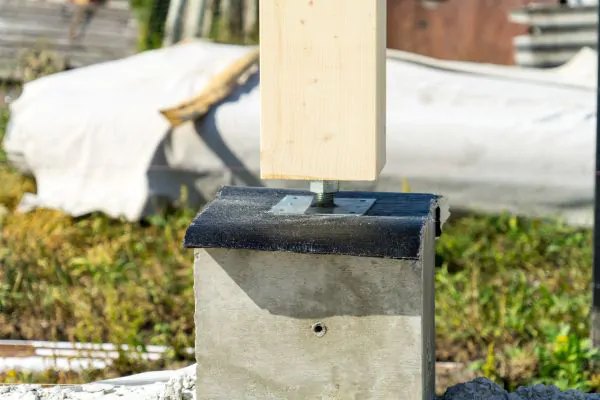
Adjustable deck supports have emerged as a valuable solution in modern construction, offering flexibility and adaptability for versatile deck designs. These supports typically consist of adjustable pedestals or piers that can be modified to accommodate varying heights and terrain conditions.
Providing a stable foundation, adjustable deck supports allow for creating multi-level decks, rooftop decks, or decks on uneven surfaces. Their versatility enables architects and homeowners to explore creative and functional deck designs that suit different aesthetic preferences and practical needs.
Benefits of Adjustable Supports in Uneven or Sloping Terrain
One of the primary benefits of adjustable supports is their effectiveness in addressing uneven or sloping terrain. In areas where the ground is not level, traditional deck construction may pose challenges. Adjustable supports, however, can be individually adjusted to account for variations in height and slope. This adaptability eliminates the need for extensive and costly site preparation, making it easier to install decks on surfaces that would otherwise be considered impractical. Whether on a hillside or rooftop, adjustable supports provide a level and stable foundation, ensuring a secure and aesthetically pleasing deck in diverse topographical conditions.
Considerations for Height Adjustment and Leveling
Considerations for height adjustment and leveling are crucial aspects when employing adjustable deck supports. These supports typically feature mechanisms that allow for precise adjustments to achieve the desired deck height and levelness. It’s important to take into account factors such as load-bearing capacity, material durability, and ease of adjustment. Additionally, the ability to fine-tune the height ensures that the deck remains level over time, adapting to changes in the surrounding environment. Careful attention to these considerations during the planning and installation phases ensures that adjustable supports contribute to the versatility of deck designs and their long-term stability and functionality.
Factors to Consider When Selecting Your Deck Footing
When selecting your deck footing, several factors should be carefully considered to ensure a stable and durable foundation for your deck.
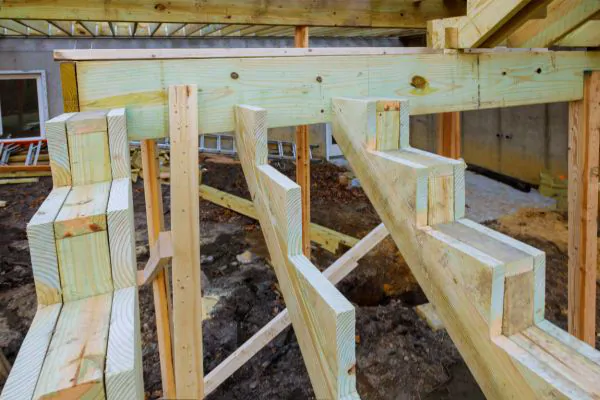
Analyzing Soil Types and Local Climate Impact
Understanding the type of soil prevalent in your area is essential for choosing the right deck footing. Different soils have varying load-bearing capacities, and certain footings may perform better in specific soil conditions. Additionally, consider the local climate impact, including factors like moisture content and frost depth. For example, regions with freezing temperatures may require footings designed to resist frost heaving. Analyzing these soil and climate factors will help you choose footings that can withstand the environmental conditions of your location.
Budget Considerations for Different Footing Options
Budget considerations play a significant role in selecting the appropriate deck footing. Various footing options, such as concrete piers, helical piles, or adjustable supports, come with different costs associated with materials, labor, and installation. Assess your budget constraints and weigh them against the benefits and longevity of each footing type. While some options may have higher upfront costs, they could prove cost-effective in the long run due to their durability and minimal maintenance requirements.
Compatibility with Deck Design and Aesthetic Preferences
The chosen deck footing should seamlessly integrate with the design for your deck project and align with your aesthetic preferences. Consider factors such as the height and visual impact of the footings, especially if your deck is elevated or has multiple levels. Some footings, like adjustable supports, offer flexibility in achieving specific deck heights and can be discreetly hidden beneath the deck structure. Take into account the overall design aesthetics, ensuring that the chosen footing complements the visual appeal of your deck.
By carefully considering the type of soil, local climate impact, budget constraints, and compatibility with design preferences, you can make an informed decision when selecting the right deck footing for your project.
You might like: 5 Reasons You Should Hire A Professional Deck Builder In Connecticut | The Smart Choice
Other Things To Know About Deck Construction
A deck project involves careful planning and execution of key elements like joists, deck posts, deck blocks, and post footings, which collectively contribute to the structural integrity and longevity of the deck.
● The joist serves as the backbone of the deck, forming the framework upon which the entire structure rests. These horizontal supports are strategically placed to distribute the load evenly, ensuring stability and strength. Consideration of the type of joist material and proper spacing is crucial to support the deck’s surface adequately.
● Deck posts play a pivotal role in providing vertical support to the deck structure. These vertical elements are strategically positioned to bear the weight of the deck and any additional loads, contributing to the overall stability and safety of the construction. The proper installation of deck posts involves securing them on reliable foundations known as post footings.
● Post footings serve as the anchor points for deck posts, designed to prevent shifting and settling. Ensuring the footings are set at an appropriate depth, considering factors such as the frost line in the region, is essential for mitigating potential issues like frost heave, which can compromise the stability of the entire deck.
● Deck blocks are integral components that provide a stable base for deck posts. These blocks are strategically placed on level ground, distributing the load evenly and preventing the sinking or tilting of the posts over time. Careful attention to the placement of deck blocks is paramount to the overall success of the project.
These aren’t the only parts of a deck. You have your railings, fasteners, decking boards, stairs, deck skirting, and many more. There’s a lot of work and parts involved when building a safe and good-looking deck. And we’re proud to say that we have been building safe and beautiful decks for many years.
Conclusion
Whether you’re going for a traditional concrete pier with Sonotubes for a cleaner and simpler installation, helical piles for efficiency across various types of soil, or adjustable deck supports for versatile designs, it’s important to know that these deck footing options have their own sets of pros and cons.
Considerations for selecting the right deck footing involve analyzing the type of soil and local climate impact. Understanding the load-bearing capacities of different soils and considering factors like frost depth is crucial for ensuring the footing can withstand environmental conditions. Budget considerations are also important, as various footing options come with different costs associated with materials, labor, and installation. Compatibility with deck design and aesthetic preferences is another critical aspect, ensuring that the chosen footing integrates seamlessly with the deck’s overall design and visual appeal.
If you’re feeling a little overwhelmed about all of this, why not give Ludlow Deck Builders a call at 203-904-2564? We serve a lot of the towns and cities in Connecticut. As an experienced and well-trusted deck-building contractor, we can guide you every step of the way. Building deck footings is something we’ve done for years, and no matter the condition of your soil and the type of deck you want to go for, we are confident that we can deliver an exceptional job!



